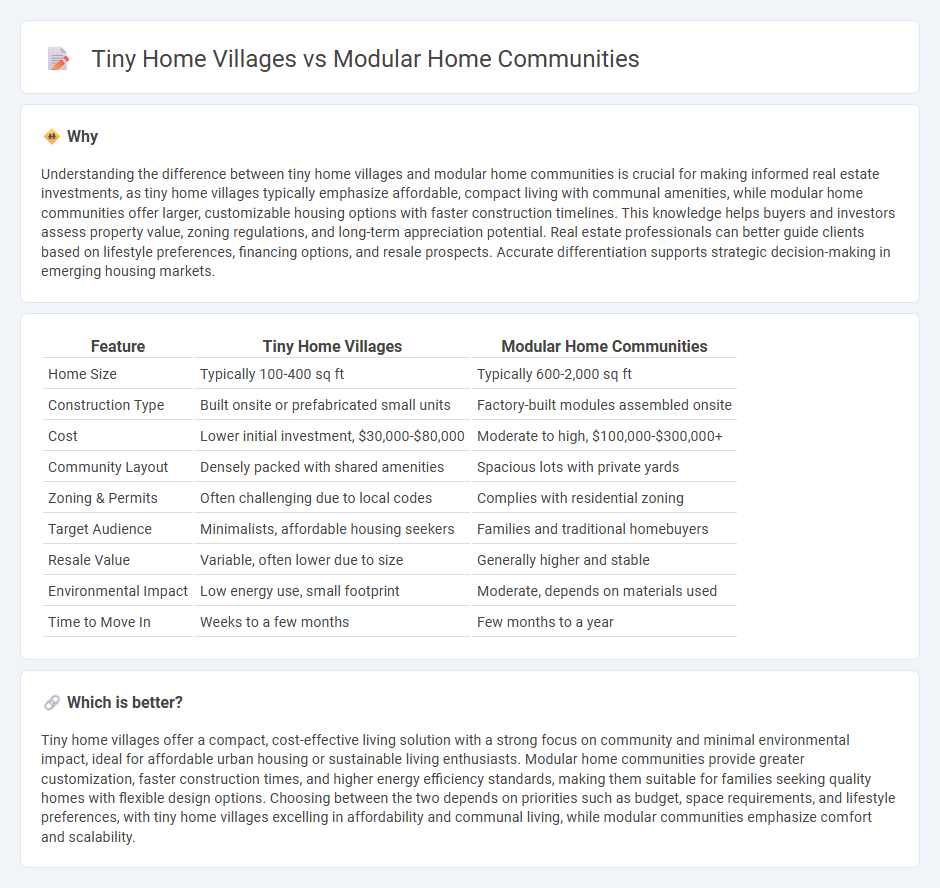
Tiny home villages offer affordable, compact living solutions ideal for minimalist lifestyles and sustainable communities, while modular home communities provide customizable, factory-built houses with quicker construction times and higher resale values. Both options address housing shortages with efficient use of space and resources but cater to different preferences regarding size, layout, and permanence. Explore the benefits and differences between tiny home villages and modular home communities to find the best fit for your housing needs.
Why it is important
Understanding the difference between tiny home villages and modular home communities is crucial for making informed real estate investments, as tiny home villages typically emphasize affordable, compact living with communal amenities, while modular home communities offer larger, customizable housing options with faster construction timelines. This knowledge helps buyers and investors assess property value, zoning regulations, and long-term appreciation potential. Real estate professionals can better guide clients based on lifestyle preferences, financing options, and resale prospects. Accurate differentiation supports strategic decision-making in emerging housing markets.
Comparison Table
| Feature | Tiny Home Villages | Modular Home Communities |
|---|---|---|
| Home Size | Typically 100-400 sq ft | Typically 600-2,000 sq ft |
| Construction Type | Built onsite or prefabricated small units | Factory-built modules assembled onsite |
| Cost | Lower initial investment, $30,000-$80,000 | Moderate to high, $100,000-$300,000+ |
| Community Layout | Densely packed with shared amenities | Spacious lots with private yards |
| Zoning & Permits | Often challenging due to local codes | Complies with residential zoning |
| Target Audience | Minimalists, affordable housing seekers | Families and traditional homebuyers |
| Resale Value | Variable, often lower due to size | Generally higher and stable |
| Environmental Impact | Low energy use, small footprint | Moderate, depends on materials used |
| Time to Move In | Weeks to a few months | Few months to a year |
Which is better?
Tiny home villages offer a compact, cost-effective living solution with a strong focus on community and minimal environmental impact, ideal for affordable urban housing or sustainable living enthusiasts. Modular home communities provide greater customization, faster construction times, and higher energy efficiency standards, making them suitable for families seeking quality homes with flexible design options. Choosing between the two depends on priorities such as budget, space requirements, and lifestyle preferences, with tiny home villages excelling in affordability and communal living, while modular communities emphasize comfort and scalability.
Connection
Tiny home villages and modular home communities share a focus on affordable, efficient living by utilizing pre-fabricated construction to reduce costs and build times. Both housing models emphasize sustainable development and community-oriented designs that maximize limited space in urban and suburban areas. This connection promotes innovative real estate solutions addressing housing shortages and increasing demand for flexible, scalable residential options.
Key Terms
Zoning Regulations
Zoning regulations for modular home communities typically allow for larger structures and standard residential amenities, reflecting their classification under conventional housing codes, whereas tiny home villages often face restrictive zoning due to their unconventional size and use, limiting placement and utility connections. Modular homes benefit from clearer regulatory pathways as they conform to established building codes, while tiny home villages require special permits or variances to comply with local land use policies. Explore detailed zoning requirements and strategic planning tips to navigate these regulatory landscapes effectively.
Infrastructure Requirements
Modular home communities require more extensive infrastructure, including full utility hookups such as water, sewage, electricity, and roads designed to accommodate larger homes and vehicles. Tiny home villages typically rely on minimal infrastructure, often incorporating composting toilets, solar power, and simpler water systems to maintain low environmental impact and cost efficiency. Explore detailed infrastructure comparisons to determine the best fit for your housing project.
Community Governance
Modular home communities often feature structured community governance with formal homeowner associations, rules, and elected boards to manage shared spaces and enforce regulations. Tiny home villages typically embrace more flexible, grassroots governance models emphasizing resident participation and collective decision-making to maintain a close-knit atmosphere. Explore the distinct governance approaches of these communities to find the best fit for your lifestyle preferences.
Source and External Links
Supporting Manufactured Home Communities - This webpage discusses the challenges and benefits of manufactured home communities, including ways to preserve them through resident-owned solutions.
Manufactured Home Communities For All Ages and 55+ - Sun Communities offers a variety of manufactured home communities with modern amenities tailored to different lifestyles.
Manufactured Housing Communities in the U.S. - This resource provides data and insights into the number and distribution of manufactured home communities across the United States.
 dowidth.com
dowidth.com